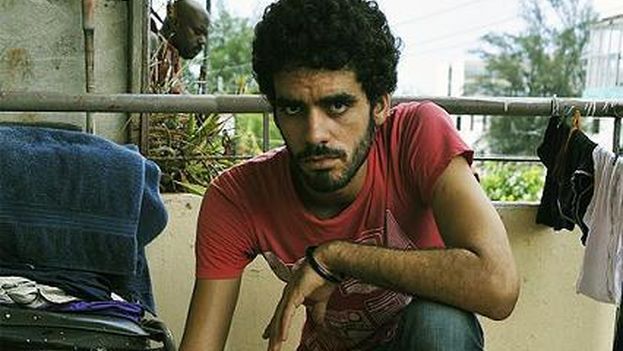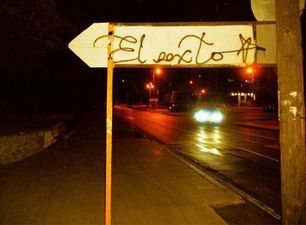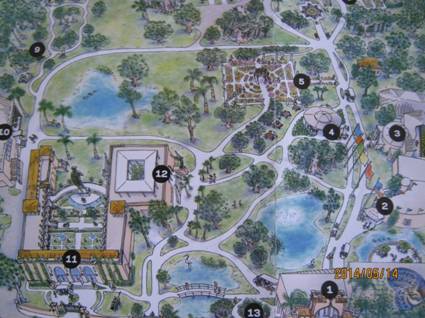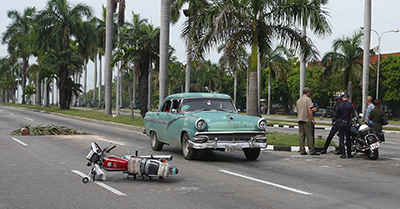
We spoke with El Sexto, the young man who has made graffiti one more method of denunciation.
Yoani Sánchez, Havana | June 26, 2014 – Winking at art, a non-authorized decoration on the walls, graffiti maintains its irreverent and clandestine air that distances itself from galleries and approaches our eyes.
If one day there is a tour of Cuban graffiti, it will have to include this gangly young man called El Sexto*. A character of the night, of agile fingers, he has marked facades, bridges and traffic signs all over Havana with his art.
Many consider him an artist, others accuse him of vandalizing the city and marking landmark places, but, how does El Sexto see and construe himself?
Question: Graffiti, performances, paintings, charcoal draawings… you work in many techniques.
Answer: I have tried to insert new technologies in my work as well. For example, I developed a line of placing QR codes (quick response code) messages about Cuban society and politics. After leaving them stuck to walls, on products in the market, on the wall of a cell in the police station… People were very curious tio know what the little quadrangle filled with pixels was saying, so they would look for someone with a smart phone with the QR reader application to understand them.
Then they would read the message: “El Sexto,” “Down with the Castros!” or the dissemination of some event on the alternative scene. It was a form of mocking censorship through new technologies.
Question: Many Cuban artists opt for the metaphor, perhaps to stay out of trouble and to not be censored. You go for an ever more direct language. Has no institution approached you to organize an exposition?
Answer: So far no one has approached me to present my work in any institutional gallery. I am an artist outside the permitted limits. Although the official world doesn’t accept me, other Cuban artists have offered me solidarity and encouragement. At first I thought that the art scene wasn’t looking at me, didn’t know my work. However, I’ve been in contact with some major figures such as Ezequiel Suárez, Garaicoa, Los Carpinteros, and to my surprise they value my art and are up to speed on what I’m doing. This has given me greater commitment to my work and makes me improve every project I undertake.
“I had to look out for the guards at the Museum of the Revolution in order to paint on the façade of the Museum of Fine Arts.”
Question: Can you talk about the graffiti movement in Cuba?
Answer: Yes, there are young people who are joining this phenomenon. Right now, I am working with a group that sees in the idea of painting walls as also being a way of promoting social phenomena. Helping to give a face and form to figures of the alternative scene and also artistic, technological and even journalistic projects. We create graffiti, flyers, umbrellas, shirts… with the symbols that distinguish these projects and to go to public places where people ask, “And this, what’s this?” A way of arousing curiosity and disseminating these phenomena.
Question: In the last year you left the country for the first time and you were in Miami. How did that first trip abroad go?
Answer: It’s been very important in my life. Especially the stay in Miami where I could meet so many Cubans and see what they’ve managed to achieve. That gave me a lot of happiness but it also made me very sad to think of all the lives that have been shattered on this side because they don’t have freedom to fulfill themselves. I learned a lot about publicity; it nurtured me, the ways in which people want to spread an idea among as many people as possible. But I also understood on those trips that I am here, in the street, I need the Cuban streets to realize my art and to inspire me. So I returned home.

Question: You were also in The Hague, Netherlands, what did you do there?
Answer: My art tries to call attention to what is happening here. So in The Hague I gave a public performance – which coincided with the so-called Night of the Museums in that city – where I used a 24-yard chain to convey the sensation of confinement and lack of freedom that we experience in Cuba. It was very cold and my body was totally shaking in the street, while people waited in long lines to enter the museum halls, also joining the piece and creating a great impact on those who were watching.
“In The Hague I performed with a 24-yard chain to convey the feeling of confinement we experience in Cuba.”
Question: You’re always living with one foot in the street and the other in jail. Are you afraid?
Answer: I’ve been given many fines for painting facades, fines I will never pay, because it’s my art. This has been a path to my individual freedom, I’m going to build myself toward greater sincerity. Even if I’m taken prisoner tomorrow, I will continue doing it.
Question: Of all your graffiti, which do you like best?
Answer: The one that has come farthest with me is my signature, El Sexto, and although I like them all, that one in particular took me a lot of work because of the place where I did it. I had to look out for the guards at the Museum of the Revolution in order to paint on the façade of the Museum of Fine Arts, so there I am, in that place, despite censorship.
Question: Future projects?
Answer: I’m going to do a performance that has a lot to do with the direction of my career. I still don’t have a date but I’m working on it. It will be a piece in which I will refine with my art and my own body the wall where I will paint it.
Translator’s note: Follow the link for an explanation of the nom-de-plume “El Sexto,” whose given name is Danilo Maldonado Machado.
26 June 2014













